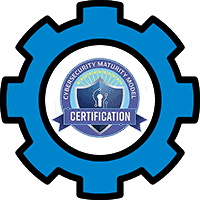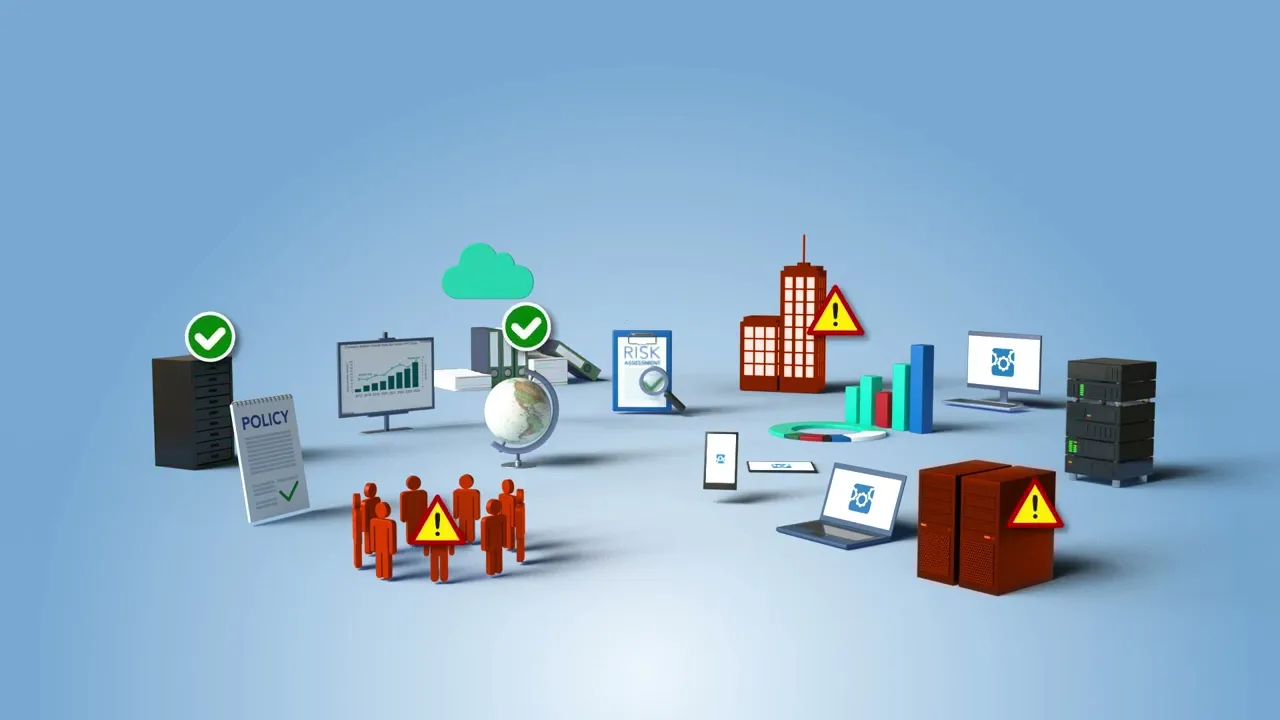Your Roadmap to Risk Reduction!
Table of Contents
ToggleThe Continuum GRC ITAM SaaS platform has hundreds of plugin modules available, such as:

Cybersecurity Maturity Model Certification (CMMC)
CMMC is a program that enables DoD contracting organizations to meet and demonstrate the security requirements embedded with FISMA and the NIST publications so that an agency may conduct business with the confidence that its contract holder is meeting those requirements.
Modules include:
- Cybersecurity Maturity Model Certification (CMMC) Level 1
- Cybersecurity Maturity Model Certification (CMMC) Level 2
- Cybersecurity Maturity Model Certification (CMMC) Level 3
Why is CMMC Important for You?
CMMC (Cybersecurity Maturity Model Certification) is important for any contractors working with the Department of Defense. Having that certification means you can safeguard our national security with elevated practices to protect our most sensitive cyber assets. This is even more important in an FFiage with increasing levels of threats to our cyber infrastructure. The CMMC assessment process helps you identify the strengths and weaknesses of your internal cyber hygiene and add appropriate controls.
Having a CMMC certification provides a competitive advantage in business and is an absolute necessity for bidding on any Department of Defense jobs.
Benefits of the CMMC Certification
Obtaining a Cybersecurity Maturity Model Certification benefits your business in multiple ways. First, the process reveals the true health of your cyber infrastructure, showing possible vulnerabilities and allowing you to fix them before something goes wrong. Knowing that you’re less vulnerable to cyber threats brings relief. Meeting CMMC requirements boosts confidence in clients and vendors.
That enhanced cybersecurity posture opens up new business opportunities, especially providing services that involve highly sensitive data. If pursuing highly prized Department of Defense contracts or bidding to provide professional services of any kind to them, CMMC is a must that gives you the advantage.
How Do I Get Started
There are different levels of CMMC certification, depending on the sensitivity of the kinds of information your organization handles and how it applies to the opportunity you’re pursuing, like a federal contract. Determine if your business needs Level 1, 2, or 3 (Level 3 is for handling the most sensitive, classified materials).
The next step is to identify the particular part of your business that will be assessed. Use NIST 800-171 standards to conduct a self-assessment, which will reveal any gaps needing to be addressed. Finally, reach out to a CMMC professional, like Continuum GRC, to get you through the more formal assessment process.
Our CMMC Services
Continuum GRC offers business advisory services around compliance, which include reviewing certification needs required for CMMC. We offer services to review and ensure IT security within your organization. Through internal and external audits, we ensure that your processes, including risk management, meet the standards for CMMC compliance and regulation.
Our cybersecurity solutions make these ongoing checks and audits much simpler. We’re versed in the standards for both the US and international CMMC compliance, staying on top of the ever-changing security landscape. We have the data center and network architecture to provide robust controls in a highly secure environment as we review your system.
What are you waiting for?
FAQ
Who needs to be CMMC certified?
Any organization that works with the Department of Defense needs to be CMMC certfied. This includes anyone involved in their supply chain, from contractors, subcontractors, and suppliers. For anyone handling controlled unclassified information or federal contract information, this compliance is a must.
What services are included in CMMC compliance support?
Services for CMMC compliance include analyzing gaps in your cybersecurity infrastructure and overall risk assessment. We offer remediation planning and implementation assistance, risk mitigation strategies, audit readiness, and continued help with ongoing compliance monitoring.
There are many steps to CMMC compliance and Continuum GRC has the solutions to simplify them all.
How do I prepare for a CMMC assessment?
Start by determining the CMMC level your organization will require (some demand much higher standards than others). Conduct an analysis to determine existing gaps in your security posture, then implement the needed controls. Document those steps and include your staff. Finally, contact Continuum GRC to guide you through a more detailed assessment.
How long does it take to become CMMC compliant?
Getting your Cybersecurity Maturity Model Certification takes anywhere from six to 18 months, depending on the current status of your cybersecurity and the CMMC level you’re trying to achieve.
Level 1 can be reached in a few months; Levels 2 and 3 may need a year or more to achieve.
Who conducts official CMMC assessments?
These are conducted by authorized, Certified Third-Party Assessment Organizations. The C3PAO will conduct a multi-day evaluation, both onsite and remotely. Documents will be reviewed and controls will be reviewed around IT systems, network configurations, and physical security. These assessments provide evidence of compliance with the control objectives.
Is CMMC compliance a one-time certification?
No. Maintaining CMMC compliance requires ongoing monitoring and assessment to ensure that the security posture of your organization is current with constantly evolving requirements. At the very least, an annual self assessment is needed to check for potential security gaps and implement remediation.
You are just a conversation away from putting the power of Continuum GRC to work for you.
Contact us using the form below or calling us at 1-888-896-6207 for immediate assistance.
About this standard
The Cybersecurity Maturity Model Certification (CMMC) is a framework developed by the U.S. Department of Defense (DoD) to enhance the cybersecurity posture of organizations within the Defense Industrial Base (DIB) that handle Federal Contract Information (FCI) and Controlled Unclassified Information (CUI). It aims to protect sensitive defense-related data by ensuring contractors and subcontractors implement robust cybersecurity practices. Below is a compliance overview of CMMC based on its structure, purpose, and requirements, incorporating relevant information from available sources.
Purpose of CMMC
The CMMC aims to:
- Protect sensitive data: Safeguard FCI and CUI against cyber threats, including advanced persistent threats (APTs).
- Standardize cybersecurity: Establish a unified set of cybersecurity requirements for DoD contractors and subcontractors.
- Ensure supply chain security: Verify that all organizations in the DoD supply chain meet appropriate cybersecurity standards.
- Align with existing frameworks: Build on standards like NIST 800-171, NIST 800-53, and CIS Controls to streamline compliance.
Key Features of CMMC
- Structure and Scope:
- CMMC 2.0 (announced November 2021, with rulemaking ongoing as of August 2025) replaced the original CMMC 1.0. It simplifies the framework into three maturity levels (down from five):
- Level 1 (Foundational): Focuses on basic cybersecurity hygiene for organizations handling FCI. Requires 17 controls aligned with NIST 800-171 and FAR 52.204-21.
- Level 2 (Advanced): Targets organizations handling CUI. Requires implementation of all 110 controls from NIST 800-171, plus additional practices for enhanced protection.
- Level 3 (Expert): Designed for organizations with CUI in high-risk environments. Includes 110+ NIST 800-171 controls, plus select controls from NIST 800-53 and other advanced practices.
- The framework organizes controls into 14 domains (e.g., Access Control, Incident Response, System and Information Integrity), aligned with NIST 800-171.
- Applies to all DoD contractors and subcontractors handling FCI or CUI, including small businesses, universities, and foreign entities.
- CMMC 2.0 (announced November 2021, with rulemaking ongoing as of August 2025) replaced the original CMMC 1.0. It simplifies the framework into three maturity levels (down from five):
- Domains and Controls:
- The 14 domains include:
- Access Control (AC): Restrict access to authorized users (e.g., multi-factor authentication, least privilege).
- Incident Response (IR): Develop and test incident response plans.
- System and Communications Protection (SC): Use encryption (e.g., FIPS 140-2 validated) for data in transit and at rest.
- Risk Management (RM): Conduct risk assessments and mitigate vulnerabilities.
- Level 1: 17 controls for basic safeguarding (e.g., password policies, physical security).
- Level 2: 110 controls, fully aligning with NIST 800-171, covering areas like audit logging and configuration management.
- Level 3: Adds advanced controls (e.g., enhanced threat hunting, supply chain risk management).
- The 14 domains include:
- Assessment and Certification:
- Self-Assessments:
- Level 1: Organizations can perform annual self-assessments and submit results to the DoD’s Supplier Performance Risk System (SPRS).
- Some Level 2 contracts allow self-assessments, with senior leadership attesting to compliance.
- Third-Party Assessments:
- Level 2 (for critical contracts) and Level 3 require assessments by CMMC Third-Party Assessment Organizations (C3PAOs), accredited by the CMMC Accreditation Body.
- Certifications are valid for three years, with annual affirmations of compliance.
- Plan of Action and Milestones (POA&M):
- Organizations can achieve conditional certification if minor gaps exist, with a 180-day timeline to close them.
- Assessments evaluate both implementation (are controls in place?) and institutionalization (are processes repeatable and documented?).
- Self-Assessments:
- Audit and Accountability:
- Organizations must maintain audit logs, system documentation, and evidence of control implementation.
- The DoD monitors compliance through SPRS scores and may conduct follow-up audits for high-risk contracts.
- Non-compliance can result in contract ineligibility, loss of awards, or penalties.
Compliance Requirements
To achieve CMMC compliance, organizations must:
- Determine Required Level:
- Identify whether they handle FCI (Level 1) or CUI (Level 2 or 3) based on contract requirements.
- Implement Controls:
- Deploy the specified controls for the target level, aligning with NIST 800-171 (Levels 1 and 2) or NIST 800-53 (Level 3).
- Examples: MFA, encryption, security awareness training, and incident response plans.
- Conduct Assessments:
- Perform self-assessments (Level 1, some Level 2) or engage a C3PAO for third-party assessments (Level 2 critical contracts, Level 3).
- Submit System Security Plans (SSPs) and SPRS scores to document compliance.
- Address Gaps:
- Develop a POA&M for any unmet controls and resolve within 180 days.
- Maintain Compliance:
- Conduct continuous monitoring, annual self-assessments, and triennial recertifications.
- Update systems to align with evolving threats and CMMC revisions.
- Train Personnel:
- Provide security awareness training and ensure personnel handling CUI undergo background checks.
CMMC in Practice
- Adoption:
- Mandatory for all DoD contractors and subcontractors handling FCI or CUI, with phased implementation starting in 2025 (rulemaking expected to finalize by early 2026).
- Impacts over 220,000 organizations in the DIB, including small businesses and cloud service providers.
- Key Updates in CMMC 2.0:
- Simplified from five levels to three, reducing complexity.
- Reintroduced self-assessments for Level 1 and some Level 2 contracts to ease burdens on small businesses.
- Removed CMMC-specific practices and maturity processes, aligning more closely with NIST 800-171.
- Introduced POA&Ms to allow conditional certifications.
- Integration with Other Standards:
- Builds on NIST 800-171 (core for Levels 1 and 2) and NIST 800-53 (Level 3).
- Aligns with CIS Controls, ISO 27001, and FedRAMP, enabling organizations to leverage existing compliance efforts.
- Maps to CJIS Security Policy for organizations handling criminal justice information.
- Resources:
- CMMC Accreditation Body: Provides guidance, assessor training, and C3PAO accreditation.
- DoD’s Project Spectrum: Offers free tools, training, and templates for CMMC compliance.
- Cloud Service Providers: Platforms like AWS GovCloud, Microsoft Azure Government, and Google Cloud offer CMMC-compliant environments.
- Challenges:
- Cost and Complexity: Small businesses may face high costs for assessments and control implementation (estimated $3,000-$100,000+ depending on level).
- Supply Chain Oversight: Prime contractors must ensure subcontractors comply, increasing coordination efforts.
- Assessment Bottlenecks: Limited C3PAO availability may delay certifications.
How Organizations Can Use CMMC
- Contractors:
- Review DoD contracts to determine the required CMMC level.
- Implement NIST 800-171 controls (using tools like Continuum GRC for compliance monitoring).
- Engage C3PAOs for Level 2/3 assessments or use self-assessment tools for Level 1.
- Subcontractors:
- Align with prime contractor requirements and provide evidence of compliance (e.g., SPRS scores).
- Leverage cloud providers with CMMC-compliant offerings to reduce implementation burden.
- Auditors:
- Use CMMC assessment guides and NIST 800-171 mappings to evaluate control implementation.
- Verify documentation, including SSPs, POA&Ms, and audit logs.
- Cloud Providers:
- Achieve CMMC Level 2 or 3 certification to support DoD customers.
- Provide transparency on data handling and compliance through attestations or reports.
Conclusion
The CMMC 2.0 framework is a critical DoD initiative to secure FCI and CUI across the defense supply chain. Its three-level structure, alignment with NIST 800-171, and flexible assessment options (self-assessments and C3PAO audits) make it accessible yet rigorous. Compliance requires implementing controls, conducting assessments, and maintaining ongoing monitoring, with significant implications for DoD contract eligibility. As rulemaking progresses (expected finalization in 2026), organizations should prepare by aligning with NIST standards, leveraging compliant cloud platforms, and using DoD resources like Project Spectrum. Non-compliance risks exclusion from DoD contracts, making CMMC a priority for DIB organizations.
Amazing Benefits

